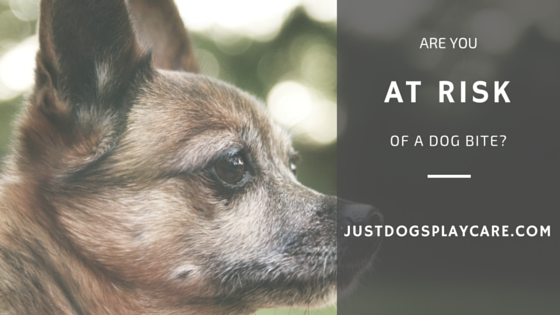
By Carol Besler-Snell on 06/02/2016

Are You at Risk of a Dog Bite?
All dogs can bite—and will, if provoked beyond their limit. Even the sweetest and cuddliest pet dog that no one would have expected to bite. It’s something we should all be aware of, whether we are dog owners ourselves or just people interacting with dogs in the world at large. When we understand and respect the fact that all dogs may bite, we can do much to prevent dog bites and the sad situations that result for all involved.
According to the Center for Disease Control & Prevention, there are more than 4.5 million dog bite cases that are reported annually in the USA. Children under 13 years are the most affected because they are not always adequately supervised and may not understand how to act around dogs or how to recognize when a dog is giving warning signs that mean they should back off.
A sad fact is that too many kids are bitten by family dogs. Hence, the importance of teaching children that every dog can bite—and how to avoid situations that may provoke a dog to behave this way.
What Can Cause Your Dog to Bite a Human?
Fear
Fear is the reason behind a large number of dog bites. Dogs with inadequate human socialization may get worried or fearful when they meet a new person…or even just someone “different” than those they are used to seeing, such as a person wearing a hat or someone in a wheelchair. Some dogs have developed a reason (in their minds) to be fearful of certain people—perhaps someone who hurt them, or maybe there was just some sort of unassociated bad memory (snagged a toenail) when they met a new person (vet).
Fear bites can also occur when a dog is startled—for instance, if a child sneaks up on them or someone jostles them while they are sleeping. These are knee-jerk reactions that happen with little warning, so it’s important to teach that surprising dogs is not a good idea and could get someone hurt.
Possessiveness
Protection of property and boundaries is a job almost all domestic dogs assume. They learn that their job is to protect what’s valuable—their humans, their land, and their possessions. Certain breeds can be more protective than others, such as herding dogs or guard dog breeds.
A good idea is to thank your dog when they bark and alert you that someone new has approached. Then call them to you and have them sit quietly while you greet the new person. Even the mail man or woman can become a friend this way! To get to this point, you must teach your dog commands like “Come,” “Sit,” “Settle,” and “Quiet.” And then you must practice these good manners a lot! Dogs won’t learn them in one attempt, so keep trying.
Other useful commands to teach dogs are “Drop It” (spit out that thing in your mouth) or “Leave It” (don’t you even think about putting that thing in your mouth!). Besides commands, teaching dogs manners is essential to preventing dog bites—behaviors such as how to take treats nicely, allowing humans to take away bones and toys, and being OK with someone nearby while they are eating.
Be aware, though, that not many people have taught their dog every command and manner in the book. So always observe and supervise your kids around dogs. Teach them not to take away dogs’ possessions (or how to give a “Drop” command to do so), and never let them disturb a dog with ANY kind of food item (a bowl of food or a rawhide bone can be equally valuable to a dog…so remember, it’s not just kibble or treats you need to watch your kids around).
Maternal instincts
Even the most well trained and friendly dog can bite when you get near her puppies. Keep distance and respect a bitch who has puppies. Teach children to avoid approaching puppies when around their mother. You should also be cautious when handling the puppies. Moreover, to avoid aggression, ensure the mother and puppies have a safe place to stay that has fewer distractions.
Warning Signs that a Dog May Bite
In my experience, dogs generally give off several warning signs before any bite occurs. These signs can be subtle and easily missed by the untrained eye—thus many bites happen when they might otherwise be avoided, if we were just better at reading a dog’s body language.
Prior to an actual bite, dogs will generally make different attempts to stop a person from doing something that they don’t like (such as grabbing them by collar). Generally they will use body manipulation (swatting you away with a paw, rolling over and getting out of the position, etc) first. If that doesn’t work, they may do an “air bite”—mouthing toward you but not on you. Successive steps include teeth on skin, teeth bruising or injuring skin, and finally, a puncture to the skin.
As a person approaching an unknown dog, you may have no idea that, for instance, this dog does not like to be grabbed by collar and has gone through the “steps” that lead up to a bite with his owners. So when you meet him on the street and reach down to pet him, he may think you are grabbing his collar and bite you pretty quickly. In his mind, he has given all the warning signs and told “humans” he doesn’t like that—so he is going to stop it quickly. This is just a reminder that all dogs can bite—and it can just take a simple thing like this to get someone bit.
Preventing Dog Bites
As owners of dogs, we owe it to them—and to society—to teach bite inhibition. That means teaching our dogs that no teeth are ever allowed on human skin. In the case of a dog who bites when you reach for his collar, you should find a good trainer to help you with “Hands on Collar” exercises…that slowly get a dog used to being touched and grabbed at and getting rewarded when he or she behaves nicely.
As people who live in the world with domestic dogs—and also stray and unknown dogs that may approach—we should learn more about dog language, about signs that a dog may bite. A freeze, a stare, ears pulled back, a low growl—these are all signs that the dog should not be approached. The most important thing you can do in this situation is LOOK AWAY and slowly turn away. Direct or intense eye contact that endures for more than a few seconds can trigger a “fight or flight” signal in dogs. Try to be calm and make slow movements. When you become less of a threat in a dog’s eyes, the dog will often back off.
Eye contact is something everyone should know about and especially be aware of with kids. I theorize that more small kids are bitten because they are often at a height about eye-level with a dog…and when they approach eye-to-eye, it can be very scary. That’s why parents should always be super-vigilant about supervising kids around dogs. Even those sweet, loving dogs you think would never bite CAN bite. And knowing that can keep everyone safer.


